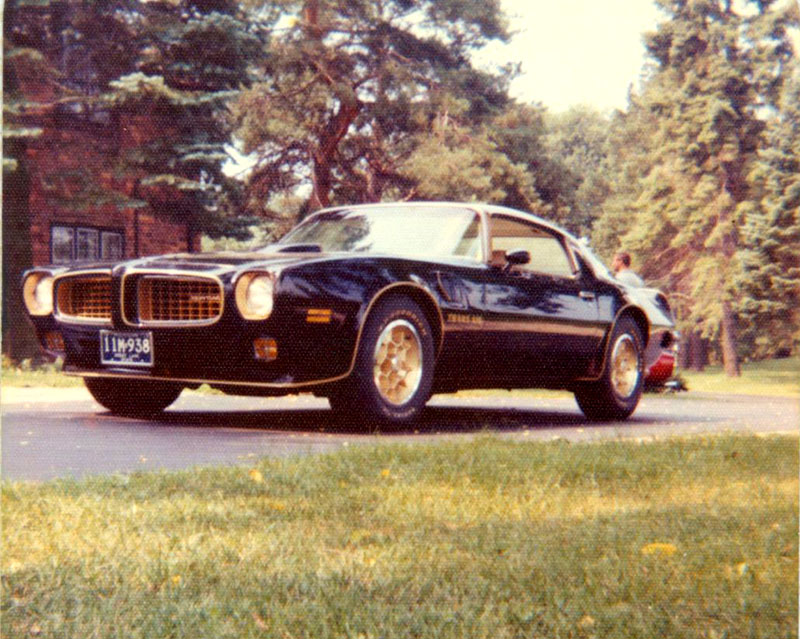
1973 before concept in Chuck Jordans driveway
(Design Vice President)
THE HISTORY OF THE MOST FAMOUS FIREBIRD
"THE 1974 CHICAGO AUTO SHOW CAR"
By Bob Phillips
**WARNING: Large pictures, loading may take time**
Originally, straight off the line, one of the first 1973 buccaneer red Trans Am 455 with a turbo 400 transmission that never made it to a dealership but went straight to the design studio to be special equipped for vice president of design Bill Mitchell as a "Brass Hat" car. Pontiac Historical Services (PHS) shows the car as a Factory Company Car
The design department headed by John Schinella (Head Chief of Design for Trans Am) painted the car black and gold. Bill Mitchell liked the Johnny Player Special Forumal One (F1) color scheme - he already had a couple motorcycles painted in the same fashion. Bill drove the car personally, as did ex-vice president of design Chuck Jordan and head cheif of design John Schinella in the early part of 1973.

1973 before concept in Chuck Jordans driveway
(Design Vice President)
John Schinella wanted to use the large bird decal on the hood of the Trans Ams, but
Bill Mitchell originally hated the idea until John put it on the black-and-gold Trans Am, parked it outside Bill‘s office next to Bill’s black and gold motorcycle, and called him up to look out his window. Bill saw the firebird and immediately liked it for the first time. Here is a great story by Jeff Denison. (This excerpt is from an article in the NFTAC Eagle).
THE MAKING OF THE BIRD
By Jeff Denison
The 1970 Pontiac Trans Am was one of the most aggressive looking cars ever to roll out of Detroit. It was also virtually an all-new car carrying over only the drive train from the previous year. There was a very important new Trans Am design car conceived for the 1970 Trans Am; the famous hood bird graphic.
Recently, I sat down with Bill Porter, the Chief Designer of the 1970 Firebird (he’s now a Chief Designer at Buick), and Ted Schroeder, the designer who put the Trans Am package together for 1970, (now a Chief Designer for Chevrolet). We discussed how the design for the giant hood bird, often referred to today as the “Screaming Chicken,” came about. Bill Porter talked about two 1970 Trans Am show cars that were being built: a bright white one at Design Staff, and a racing blue one at Pontiac’s prototype facility at Pontiac Engineering. Both of these cars were to receive the hood bird graphic -- a white one on the blue car and a blue one on the white car -- traditional racing colors without the traditional racing stripes. No one is sure who came up with the idea for the huge bird decal, but Ted remembers drawing it up and sending it to Design Staff’s graphic department, where a graphic designer named Norm Inouye (pronounced In-o-way) laid out the actual artwork before sending it to 3M Corp. to produce the prototype decals.
Bill Mitchell, GM Vice President and head of Design Staff, always kept up-to-date with current projects. While walking through the paint department one day, he noticed the finished Trans Am with the hood bird. He “hated” it and immediately called Porter on the phone, yelling that the car had “an Indian blanket on the hood,” that it looked “like a Macy’s truck” (a rolling billboard), and the “get the damned thing off immediately!”
Bill Mitchell had a way with words and the authority to back them up, so there was no turning back. The hood bird graphic was a dead issue for the time being; a bold single blue or white stripe would run the length of the 1970 Trans Am, with a small bird at the edge of the bumper.
In 1971, Bill Porter moved on to another studio and John Schinella became Chief Designer responsible for the Firebird. The racing colors of blue and white would run through the 1972 model year on the Trans Am. The new colors for the 1973 were Buccaneer Red and Brewster Green -- Cameo White would remain in the color selection, and Lucerne Blue was dropped. John took one of the prototype decals 3M had made, changed the color, and put it on a red prototype 1973 Trans Am. He literally took it to the streets, driving it up and down Woodward Avenue, talking to the “car guys” at each stop. Everyone overwhelmingly liked the hood bird.
Now came the tough part. Schinella knew the hood bird graphic was a winner but he had to sell it to management. At first, Pontiac General Manager, James McDonald wasn’t impressed with the hood bird presentation, but he agreed to go along with the Design Staff proposal if Mitchell was behind it. John knew that Bill Mitchell liked the black-and-gold John Player Special paint scheme, so he had a black prototype 1973 Trans Am made up with a gold foil hood bird graphic and gold pinstripes. No one can remember if this particular Trans Am had a Super Duty 455 or not, but if Bill Mitchell used it as his regular car, it probably did. Bill already had some of his motorcycles painted in a similar fashion. By pitching the hood bird to Mitchell in a color combination he already liked, Schinella sold him on the idea and the hood bird was finally born. The hood bird would go on to become an icon, one that would identify the Trans Am for the rest of the second generation’s production run. When the 1982 Trans Ams arrived at the dealerships in late 1981, the legendary hood bird and shaker scoop went into the history books -- gone but certainly not forgotten. The author wishes to thank Bill Porter, Tom Peloguin, Ted Schroeder and John Schinella of GM Design Center.
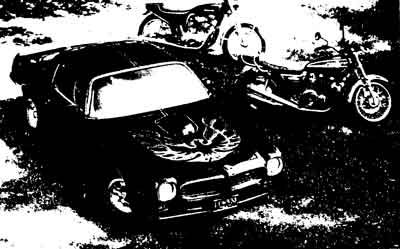
Bill Mitchell’s Johnny player car and motorcycles
Note: the 1973 nose
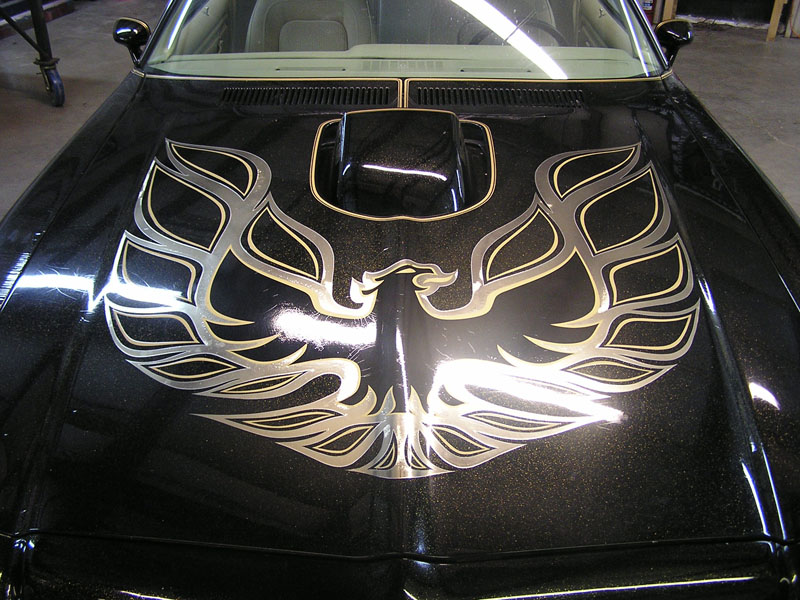
The One Off Gold Foil bird as seen today, still completely original
Gm Photo by Jerry Heasley that is used in at least 4 publications
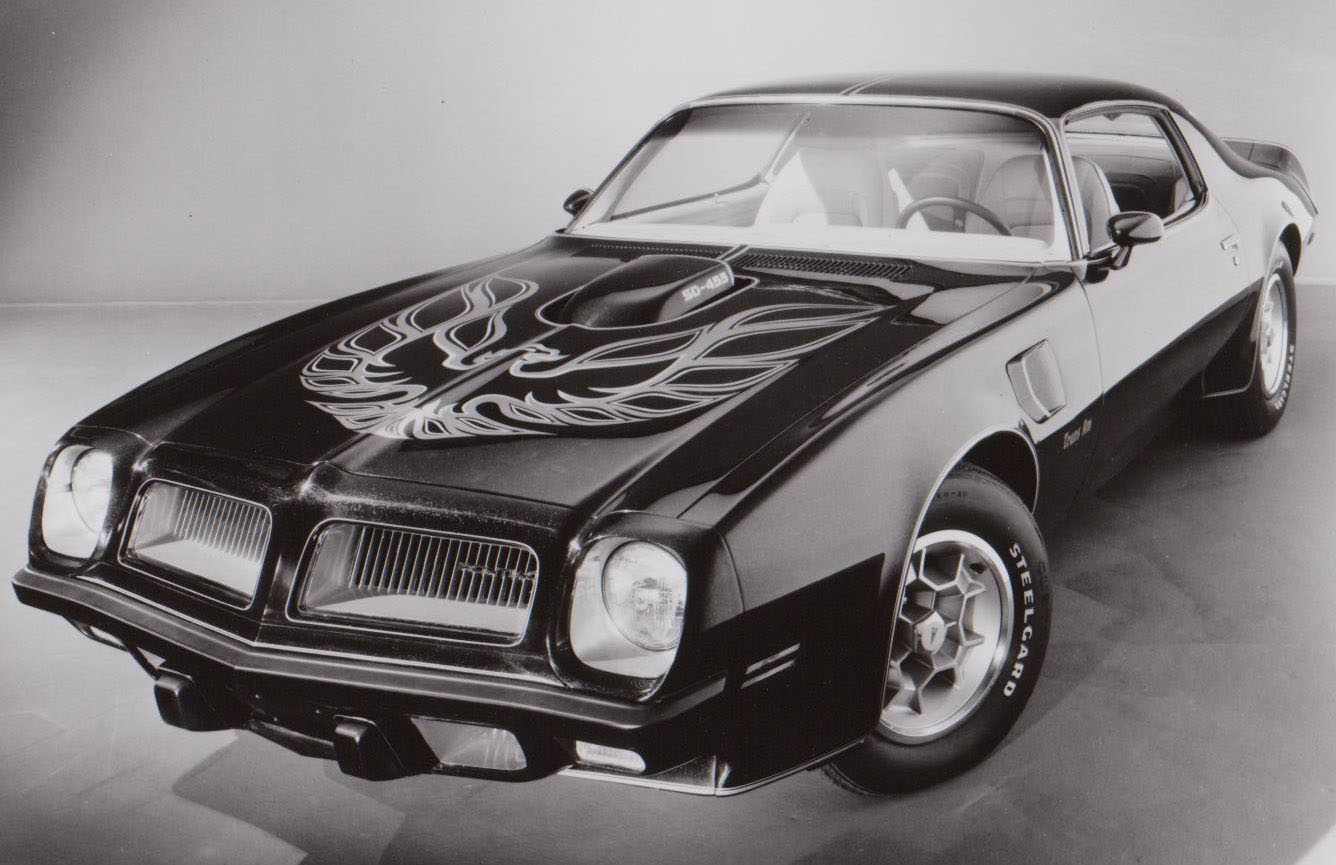
I found this factory photo of what I believe more than likely is “THE BILL MITCHELL 1974 CHICAGO AUTO SHOW CAR”. Here is my reasoning;
The car is black (wasn’t offered in 1974)
SD 455 on Shaker
Gothic lettering “Trans Am”
Interior looks like light tan
Headlights looks like the Cibie
Gold Pin stripping
Fender spats look molded
Gold flake in black paint
About the only thing I can or can’t find is the “GM design badges” but they could be in the shadows or added later. The car was always was in and around the GM design studio.
These factory photos are like the ones you get from PHS ( Pontiac Historical Services) for the year your car is that your inquiring about. In this period of time they were 8 X 10 black and white prints or reproductions( I‘m not sure which). It would be easy to take a picture while right there in the design department and being one of the first off the line.
Back to the Design Studio
Bill Mitchell wanted a prototype for the 1974 car show circuit, so the design team, headed by John Schinella, started back to work on the 1973 TA. Although the gold leaf bird and the black-and-gold paint scheme stayed the same they added molded fender spats instead of the bolt on ones used on the previous TA’s, hoping they would make it into production, but they never did (cost reasons). The 455 SD replaced the 455 engine with solenoids under the shaker that would throw open the round butterfly nostrils of the rear facing hood scoop when the driver stomped on the accelerator. The 1973 bumper was replaced with the 1974 shoveled look front bumper and rubber padding for the new safety regulations. General Motors Design badges were added to the front lower fenders along with the German Gothic lettering depicting the new Trans Am decal in true gold leaf. The Cibie head lights were integrated into the design (see references). The special silk material used on the seats and the Cadillac carpet with the stainless steel floor grates that protected the carpet from wearing (John Schinella used these grates on his other concept cars) were part of the one-off interior. The first gold dash bezel was used on this 1974 Trans Am as well as on all Limited Editions (L.E.) and later Special Editions (S.E.). Special tires made by Goodyear with gold lettering were mounted on the first gold honeycomb wheels with the geodesic design by Bill Porter (not first honeycomb but first gold ones). What they came up with was a huge success on the promotional show circuit.

Seen here at the 1974 Chicago show
The car was flaunted at Chicago, Daytona and other large gatherings and car shows across America. This thing brought more hype and talk than the red Banshee III concept seen across the room behind the Black-and-gold car in the last picture. The Banshee never made it into production but the Bandit did. Even with the Arab Oil Embargo, the 1974 production numbers for Trans Am was up thanks to promotions like this and others.
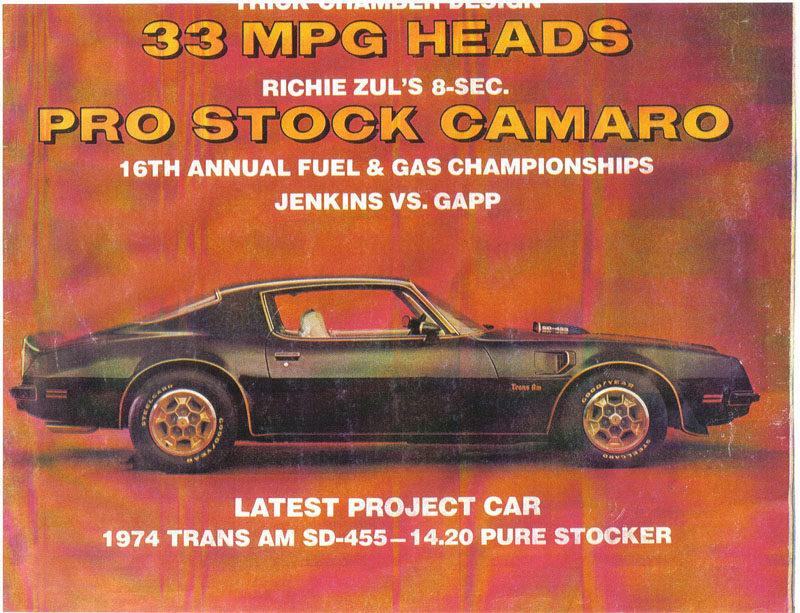
Cover of Super Stock Magazine June 1974
The excitement over the Chicago Show car prompted the release of the 1976 50th Anniversary Limited Edition and the 1977-1981 Special Editions also known as “The Bandit” from the popular movie “Smokey and the Bandit”, which came out in 1977. (Most Concept or Promotional cars don't make production, but the Chicago show car did because over 60,000 Special Editions of Black and Gold were made between 1976 and 1984)
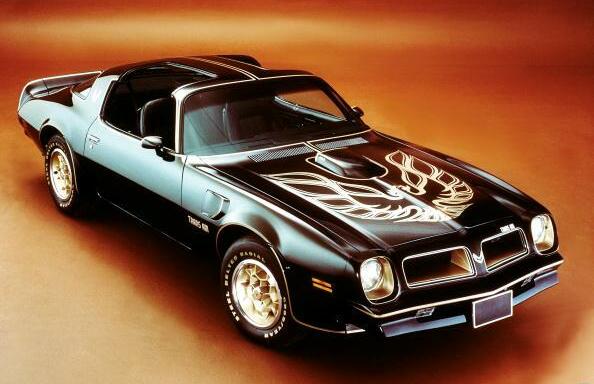
A 1976 50th Anniversary Limited Edition
After the 1974 show circuit, it’s Back to the Design Studio with the beginning of it’s new transformation to look like the new upcoming 1976 model. The new bumpers were installed along with the new wrap around back glass. Gold door jams and sills were added to help cover up the new quarters used. The car received it’s 3rd paint job in 3 years,which is why there is so much clear and is cracking (spider webbing) today.
1976 was another good year on the show circuit. I’m not sure of all its venues, (the design staff wouldn’t have put all the work into it if it wasn’t going to be shown a lot) but a couple places were the Trans AM Territories which was a gathering of Trans Am buffs and GM personnel and another was the 1976 Chicago auto show mentioned in the book
“ Pontiac The Complete History“ by John Gunnell. John Schinella told about the car being paraded around the track and pictures being taken with beautiful girls all around it at the Trans Am meets. Here is a great article from TexasTransAms.com
The History behind the name "Trans Am Territory"
Trans Am enthusiasts within Pontiac Motor Division had wanted for some time to establish special areas near race courses where Firebird owners could park their cars and socialize. Such meeting grounds had already been set aside at various tracks for other makes of cars: e.g. Corvette Corals, Porsche Parks, Datsun Z Zones etc.
GM's then design vice president William L. Mitchell, in talking to "Mr. Trans Am" John Schinella in 1975, suggested setting up a "Trans Am Teepee" along the lines of Corvette Corals. Schinella jumped at the opportunity.
Schinella's assistant designer and fellow T/A enthusiast, Bill Davis, came up with the name Trans Am Territory. Schinella passed the idea along to Pontiac general Manager Alex Mair, who felt immediately that a Trans Am Territory program was just what Pontiac needed. Pontiac public relations chief Stan Richards appointed Jill Rogers to work out the details in conjunction with John Schinella
On June 5-6, 1976, Schinella, Rogers and Dick Henderson launched the first Trans Am Territory at Road America, Elkhart Lake, Wisc. This SCCA event marked part of Pontiac's 50th anniversary celebration, and the Sports Car Club of America designated a black-and-gold 1976 Limited Edition Trans Am its official car for the 10-race 1976 Trans American Championship series.
Subsequently, Pontiac acquired a GMC motor home - called the Trans Am Traveler - and soon established Trans Am Territories not only at Road America but also at Watkins Glen, Mosport, Road Atlanta, Mid-Ohio, Michigan International, Laguna Seca, Riverside and Pocono raceways. Each became a greater success than the one before, sometimes with a many as 325 Trans Ams and other Firebirds in attendance.
Schinella rarely missed one of these events, and Rogers never did. Other regular visitors included Stu Schuster, Russ Dunbar, Wade Greenisen Jr. and George T. Reganis. The Type K, Silverbird, Banshee III and various special Firebirds were usually displayed in roped-off areas. Local Trans Am clubs turned out en masse. Firebird owners could usually take at least a parade lap around the track.
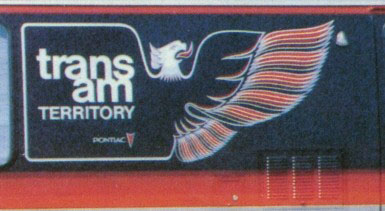
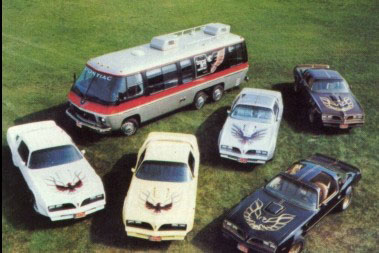
Taken in 1976 at one of the Trans Am Territory meets
Top picture taken of side of the bus
Sometime after the 1976 season, Bill Mitchell gave or sold the car to Clarence Sproul the Head Accountant of GM. Many people wanted the car. I talked with John Schinella and he told me that he was furious because he wanted the car and if anyone should have the car it should’ve been him (it had been in and around his possession or the design studio’s since 1973). GM wouldn’t let him have it because of the department he was in (some kind of liability thing). I don’t know what that exactly meant, but he didn’t get it. There is a story out there about the pull the accountant must of had to come up with the car (more on this later I hope).
Clarence once put the car up for sale in his front yard in Broomfield MI in the late 70’s. There was a for sale sign found under the front seat. The area code on the sign was 313 and that was changed, I was told, back in the late 70’s or early 80’s. All the sign said was “Mfg. by GM design staff” on a 3x5 card. It would be very interesting to know what price he was looking for, but it didn’t sale and I‘m glad, that would have meant me not acquiring it.

Few people knew what happened to or where the car was until 2004 when Bob Reason got an email from a man wanting to know if he was interested in a 1973 SD TA. Clarence had passed and his estate was for sale. Here is Bob’s story emailed to me:
Bob P.
A person saw me bidding on Ebay on a 1973 SD Trans Am and emailed me wanting to know if I was interested in buying their car. After the person described the car and the GM design badges on the fenders I thought it might be the lost car. I made an appointment to see it and was amazed when I saw it in the basement garage of Clarence Sprouls home.
When I asked for the keys to start the car, the person showing it to me said that he would have them in a few days after he bought the house where it was located. I asked him if he was the owner and he said that he was buying it with the house. His story was shaky so I did a little detective work and researched the home’s address and found that the owner of the house was in fact Clarence Sproul (deceased) and that his son was listed as the executor of his trust at the register of deeds office in Oakland County.
I contacted the Sprouls’ son and told him I was interested in buying his father’s car. His first question was "how do you know about my dad’s car?" I answered that someone was trying to sell it to me. Sprouls’ son is a Michigan State Trooper, and when I told him what was going on, he wanted to contact the buyer of his father’s house and rip him a new one, but I calmed him down.
I told him that in a few days, the car was no longer going to be his after the house sale was closed because the buyer was going to own it under the contents provision in the purchase agreement. He contacted his attorney and verified what I said was true and wanted to get the car out of the garage. I told him that I just wanted to buy the car and not get involved with his buyer and offered to store the car for him in my warehouse, at cost, until he decided what to do with the car. I made arrangements to have the car shipped to my location and stored the car for a few weeks and never called the Trooper to ask him to sell me the car.
One day a few weeks later I received a call from him and he asked me " do you still want to buy my father’s car?". I answered, yes, and he requested a cashiers check the next day and I then closed the deal and got the title and keys to the car.
Good Luck, Bob Reason

John Schinella and Bob Reason 2004

John Schinella’s signature 2004
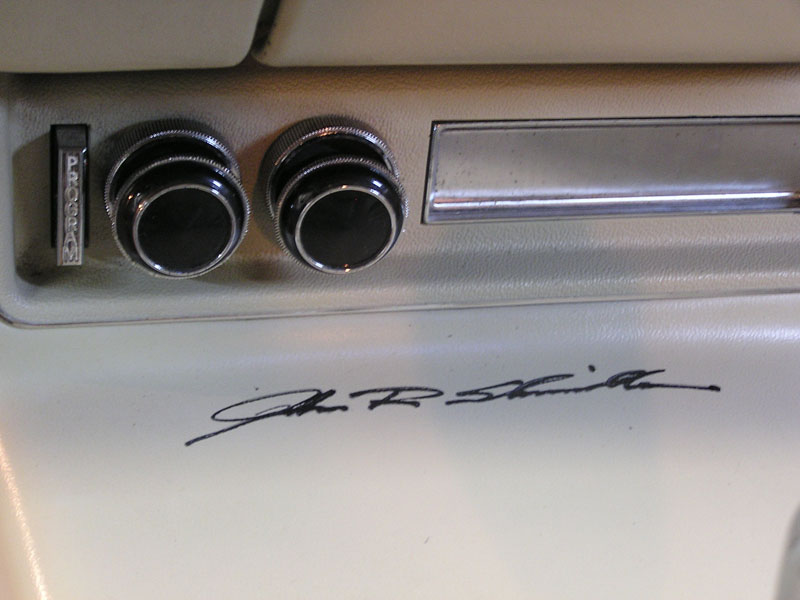
John Schinella’s signature 2004
Bob Reason looked up John Schinella and found out he only lived about 10 miles from him. They made contact, and John came by Bob’s warehouse and confirmed this was truly the concept car that he had designed years ago. This was an emotional time for John when he signed the car’s console and engine core support. Here’s what Bob wrote to me in August 2007 on what he knew about the car:
Bob P.
The 1973 T/A was a true design car because it was delivered directly to the GM design division as evidenced by the PHS (Pontiac Historical Services) papers. James Madison of PHS informed me that all true design cars never were delivered through any dealership.
Schinella informed me that Bill Mitchell wanted a Johnny Player paint scheme car, so he had the red 73 TA painted to resemble the race car.
The hood bird was and still is a one of a kind gold metal leaf bird and is original to the car since its black and gold paint job.
The wheel flares on the car were a Schinella design that he pitched to GM but never got off the ground because of cost.
The engine does not have any vin numbers on it because it was planted in the car off the shelf as part of getting it ready for the Chicago auto show in the fall of 1973.
The heads are early pre "16" stamp heads and the intake and carb are very early 1973 SD parts. Remember, the SD came out late that year. It maybe one of the 1st engines.
The rear quarters were altered to receive the 1974 rear end, as evidenced by the welding in the trunk.
The rear window was cut in to fit the 1975 design and later years.
The wheels are true gold wheels from day one and not painted.
The tires were made just for this car with gold letters.
Interior seats are covered in a silk parachute material. Gold plated interior door jams were made to cover the new rear quarters.
Schinella informed me that the car was to be crushed but somehow Clarence Sproul, an accountant at Pontiac, somehow was able to purchase it.
I found a for sale sign and a hand written card under the passenger seat with his phone number on it from way back in the 1970's when the area code was still 313. If you have that card it, reads GM design car for sale.
Schinella started Trans Am Nation (Territories) with this car and the v-12 concept. He used it as his daily driver and put most of the miles that are on it today.
I had him sign the car in my presence to authenticate it and preserve its value and to shut up skeptics.
If I remember any more I will let you know.
Bob Reason
I believe the car fell through the cracks and I caught it. Bob Reason sold the car to Mopar Collectors Tom Lembeck and Bill Parodi who tried to sell the car several times via the internet and eBay, but very few believed it was the original, famous show car. The comments on the “contact the seller” were the same; didn’t believe it, and thought it was lost, wrecked or crushed. Here are a few of the comments from the sale:
Q: Do you have documentation stating why and when the quarter panels were changed? The car in the ‘74 show has the pre-‘76 quarters and yours has the ‘76 and later quarters and rear window.
Q: How come the front ends are different from the promo car in the pic at the show. The front end looks like a 1974 at the show and yours looks like a 1976?
Q: Besides the ‘75 & later quarter panels and the ‘76 nose, how is it possible that the car is un-restored with original paint when the picture of the 1974 Chicago Auto Show clearly shows the car with ‘70 thru ‘74 quarter panels and ‘74 clip?
Q: I thought the car was destroyed. How could this be the car?
What’s really cool, Bob Reason wrote in comments during the auction trying to explain what the car had been through but it seems nobody was listening or didn’t believe it. There hadn’t been any complete information or documentation on this car (just fragments here and there in books and on websites) until now and I’m sure there is more to be found. Seems like I find something almost every week.
After a lot of research and talking to a few knowledgeable people about the car, I called Bill Parodi and flew to Texas to see it. When I saw the car, immediately I knew it was in fact the famous show car. We made a deal and the rest is History.
There was an episode of “Car Crazy” that talked about the car in the “how much do you know” question section. I haven’t seen it yet but plan on finding it.
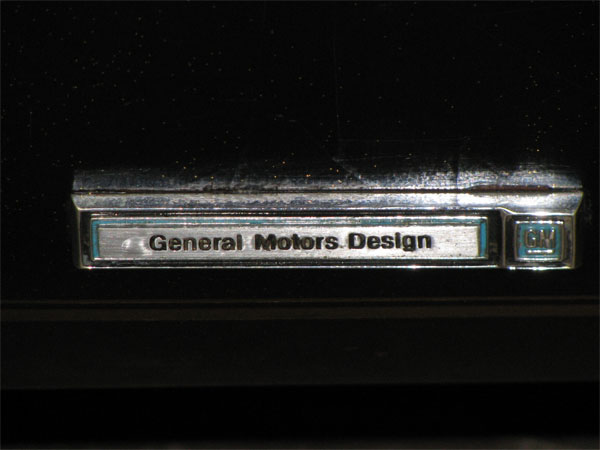
The Design Badge
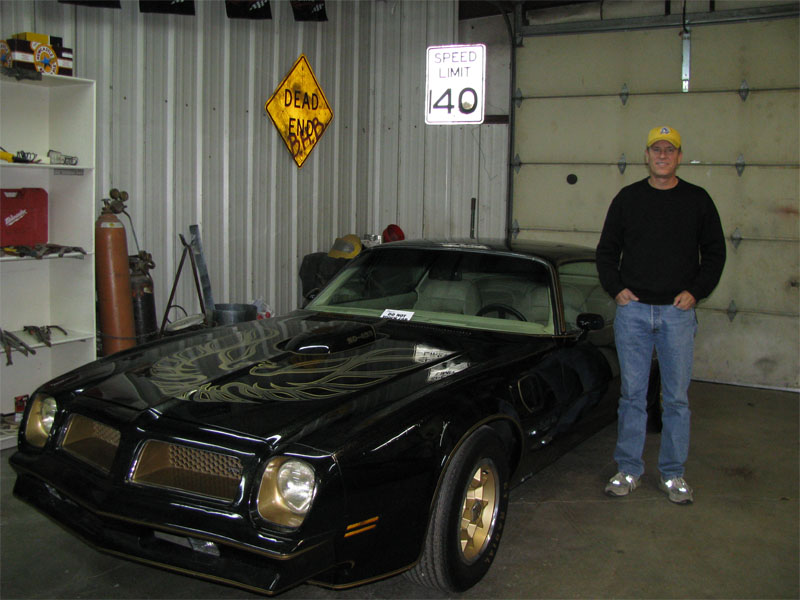
New owner
Here is an article in “High Performance Pontiac” by Don Keefe called “Bill Mitchell’s’73-’74 Trans Am”


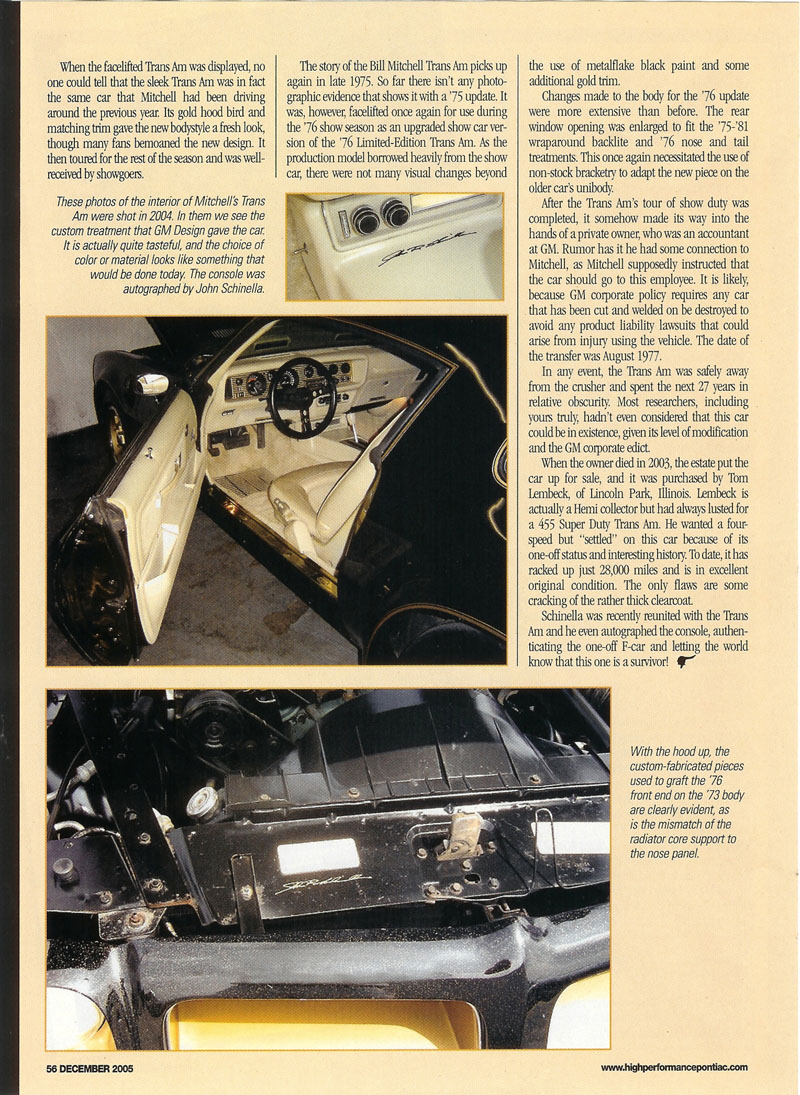
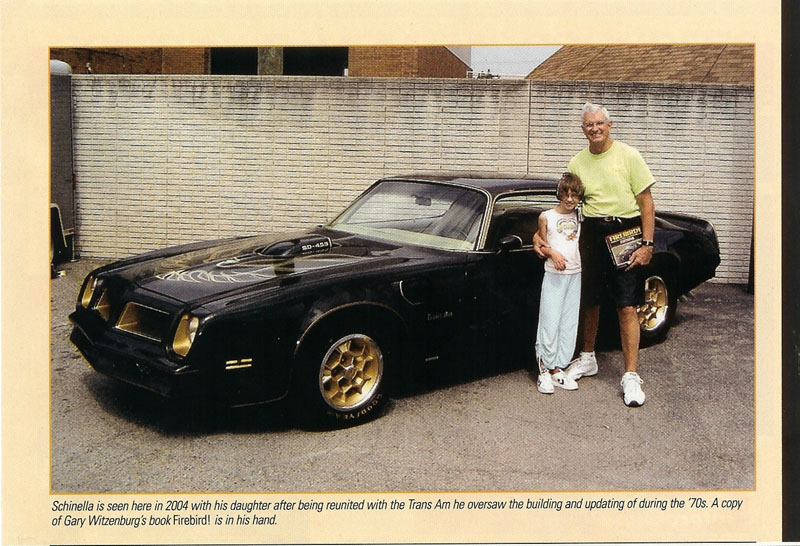
These pictures and article above are courtesy of High Performance Pontiac Magazine, December 2005, Volume 26. No 12
I have contacted John Schinella and Bob Reason and others. We have talked in length about this car. One comment I’ll never forget is John said I was a “lucky man”. Pretty cool, huh!
We are planning another Show Circuit for 2008 (fourth year used as a promotional car). Hope you can come out to see this car on its new show circuit.
This is what I know or what I’ve been told and am still trying to gather information on this Famous Bird. If you have any information, pictures, or comments, I am all ears.
Thanks for reading and hope to hear from you soon.
I want to give a special thanks to all the people that have helped! And give credit where it is due!
Cibie Headlights
Cibies are replacement headlights, legal in Europe but not really in the US, that offer a much better view. Though expensive, you only need to replace the bulb, not the complete headlight assembly when they burn out. The wattage is legal for the U.S. The bulbs are made in Germany. Hard glass technology and up to 30% more light for low and high beams. The description of the Bulbs is "Halogen Bilux H4 Super", the manufacturer Osram. United States . Postage is $5.00 for one or more photographs shipped to Canada or foreign countries .
*The author would like to give a special thank you to: John Schinella, Bob Reason, Bill Parodi, and all the people and websites and books listed above.